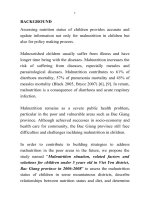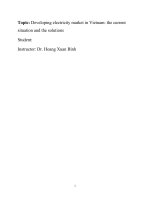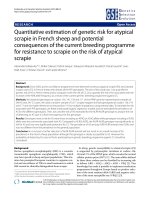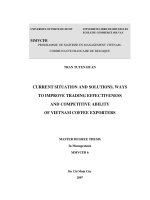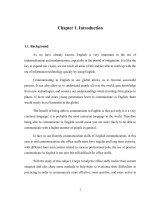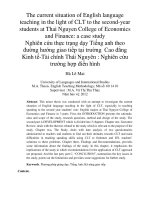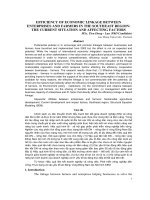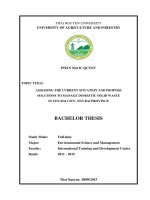Assessing the current situation and propose solutions to manage domestic solid waste in yen bai city, yen bai province
Bạn đang xem bản rút gọn của tài liệu. Xem và tải ngay bản đầy đủ của tài liệu tại đây (1.12 MB, 63 trang )
THAI NGUYEN UNIVERSITY
UNIVERSITY OF AGRICULTURE AND FORESTRY
PHAN NGOC QUYET
TOPIC TITLE:
ASSESSING THE CURRENT SITUATION AND PROPOSE
SOLUTIONS TO MANAGE DOMESTIC SOLID WASTE
IN YEN BAI CITY, YEN BAI PROVINCE
BACHELOR THESIS
Study Mode:
Full-time
Major:
Environmental Science and Management
Faculty:
International Training and Development Center
Batch:
2011 - 2015
Thai Nguyen, 30/09/2015
Thai Nguyen University of Agriculture and Forestry
Degree Program
Bachelor of Environmental Science and Management
Student name
Phan Ngoc Quyet
Student ID
DTN 1153110137
Thesis title
Assessing the current situation and propose solutions to
manage domestic solid waste in Yen Bai City, Yen Bai
Province
Supervisor
Assoc. Prof. Dr. Do ThiLan
Abstract:
The purpose of this study is to assess the current state of waste management
in the Yen Bai City, Yen BaiProvince, in order to offer appropriate solutions to
improve management efficiency. This study analyzes the issues related to
domestic solid waste in Yen Bai City such as the characteristics of solid waste,
solid waste generation, status of collection, classify, transportation and treatment
and reuse of domestic solid waste.
Yen Bai City is the political and economic and cultural center of Yen Bai
Province is the most densely populated place in the province. The status of
domestic waste management is still inefficient which leads to overlapping of
management systems and lack of synchronous investment. In addition, the sense of
environmental protection among people is still not good.
Therefore, to effectively do the management of domestic solid waste in Yen
Bai City, appropriate solutions and management strategies should be planned and
implemented immediately.
Keywords
Domestic waste, solid waste, domestic waste
management, treatment, collected, transported
Number of pages:
58
Date of submission:
September 30th, 2015
i
ACKNOWLEDGEMENT
The author would like to express his gratitude to his supervisor, Assoc. Prof. Dr.
Do Thi Lan for her invaluable useful comments, remarks, encouragement and
engagement through the learning process of this study.
He would also like to
extendhis gratitude to the lecturers who enthusiastically imparted useful knowledge on
waste treatment during the University program to all class attendants. The author also
appreciates the support of Thai Nguyen University of Agriculture and Forestry, the
coordinators and program managers for their guidance and assistance.
Furthermore, I sincerely thanks to officers in Yen Bai Environmental Protection
Agency during the implementation of the research. Special thanks also goes to the
officers of Nam Thanh Yen Bai Environment and Energy Joint Stock Company. Also,
the author would like to thank the participants in my survey, who have willingly
shared their precious time during the process of data gathering and interview in Yen
Bai city.
Finally, the author would like to express his gratitude to his family, and friends
who have helped him during the internship.
Thank you all very much!
i
TABLE OF CONTENTS
LIST OF FIGURES .........................................................................................................1
LIST OF TABLES ..........................................................................................................2
LIST OF ABBREVIATIONS .........................................................................................3
PART I - INTRODUCTION ...........................................................................................4
1.1. Rationale of the study ........................................................................................4
1.2. Objectives of the study.......................................................................................4
1.3. Research questions .............................................................................................5
1.4. Significance of the study ....................................................................................5
1.5. Limitations of the study .....................................................................................6
PART II - LITERATURE REVIEW ...............................................................................7
2.1. Legal basis..........................................................................................................7
2.2. Scientific basis ...................................................................................................8
2.3. Factual basis .....................................................................................................11
PART III - METHODS .................................................................................................19
3.1. Objectives and scope of the study....................................................................19
3.2. Location and time of study ..............................................................................19
3.3. Research contents .............................................................................................19
3.4. Research methods ............................................................................................20
PART IV - RESULTS ...................................................................................................23
4.1. Natural and socio-economic conditions in Yen Bai city, Yen Bai province ...23
ii
4.2. Situational assessment of domestic solid waste management in Yen Bai city,
Yen Bai province .......................................................................................................27
4.3. Solution proposed to increase efficiency of domestic solid waste management
in Yen Bai city ...........................................................................................................40
PART V - DISCUSSION AND CONCLUSION..........................................................45
5.1. Discussion ...........................................................................................................45
5.2. Conclusion ..........................................................................................................46
REFERENCES ..............................................................................................................47
APPENDICES ...............................................................................................................49
Appendix 1: Sample survey.......................................................................................49
Appendix 2: Photos from field’s study......................................................................52
Appendix 3: Households survey results ....................................................................55
iii
LIST OF FIGURES
Figure 2. 1- Central solid wastes management system diagram ...................................12
Figure 2. 2- Diagram State management system about DSW in Yen Bai ....................13
Figure 2. 3- The methods of solid waste treatment .......................................................14
Figure 4. 1- Yen Bai city map .......................................................................................24
Figure 4. 2- The percentage of solid waste in generation sources ................................27
Figure 4. 3- The component percentage of domestic waste in Yen Bai city.................31
Figure 4. 4- The organization structure of Nam Thanh Yen Bai Environment and
Energy Joint Stock Company ........................................................................................32
Figure 4. 5- The percentage of garbage generated and collected in Yen Bai city ........34
Figure 4. 6- Diagram the domestic waste collection and transportation process for in
Yen Bai city ...................................................................................................................35
Figure 4. 7- The diagram of domestic waste treatment process ....................................39
Figure 4. 8- Organizational diagram of environmental sanitation co-operative ...........43
1
LIST OF TABLES
Table 2. 1- Methods to treat domestic waste .................................................................18
Table 4. 1- Volume of solid waste from various sources (2014) ..................................27
Table 4. 2- Total volume of domestic waste in recent years .........................................28
Table 4. 3- Amount of domestic waste in households ..................................................29
Table 4. 4- The Components of Domestic Waste in Yen Bai City (2014) ...................31
Table 4. 5- The percentage of garbage generated and collected ...................................34
Table 4. 6- Vehicles for collection and transportation of Nam Thanh Yen Bai
Environment and Energy Joint Stock Company ...........................................................35
2
LIST OF ABBREVIATIONS
BOD
Biochemical Oxygen Demand
COD
Chemical Oxygen Demand
DSW
Domestic Solid Waste
EPA
Environmental Protection Agency
GDP
Gross Domestic Product
JSC
Joint Stock Company
MONRE
Ministry of Natural Resources and Environment
ODA
Official Develop Assistance
TOC
Total Organic Carbon
3
PART I
INTRODUCTION
1.1. Rationale of the study
Yen Bai city is the political center of Yen Bai province. It can be concluded
that the province has reached its maximum economic growth in the past years
through the development of various sectors. However, the current status of general
waste and domestic waste in particular have not been fully evaluated and audited,
provided that this leads to difficulty in collection and waste management. No
appropriate measures on proper disposal has been done. Therefore, the assessment of
the current status of the management and treatment of household waste is one of the
vital problems of Yen Bai city.
The purpose of this research is to have an access to the situation of Domestic
Solid Waste (DSW) management system in Yen Bai City. The study will mainly focus
on the advantages and disadvantages in waste management in order to find the rational
management solutions for domestic solid waste management system in Yen Bai City.
From there, we can improve the effect in solid waste management and reduce the
pollution because of the irrational collection, transport and treatment system.
1.2. Objectives of the study
- Evaluate the current situation of environmental pollution caused by domestic solid
waste in Yen Bai city.
o Collect and analyze information, synthesize the materials related to arising of
domestic solid waste from residential areas, offices, schools and trade areas in
Yen Bai City.
4
o Execute fieldworks to assess the current status of domestic solid waste arising
as well as other environmental problems:
Identify sources of solid waste and amountsof solid waste components
Method of solid waste collection and treatment
- Propose solutions to reduce the pollution caused by domestic solid waste from
residential areas, offices, schools and trade areas
o Propose solutions to strengthen the DSW management capacity of state
managing agencies.
o Propose management measures, domestic waste disposal in accordance with the
actual conditions of the city
o Raise awareness of the local people on the current environmentalissues.
1.3. Research questions
- What is current situation of the solid waste collection, transport and treatment in
Yen Bai city?
- What are the solutions to manage domestic waste in study area?
1.4. Significance of the study
1.4.1. Practical significance
The study of domestic solid waste situation of the Yen Bai will be vital to know
the strengths, weaknesses, challenges and shortcomings in the wastewater
management and treatment in order to find solutions for environmental protection in
accordance with the conditions of the city which will allow better environmental
management.
5
1.4.2. Learning significance
- Help students apply theory into reality in order to practice the data synthesis and
skills analysis.
- Propose a favorable condition for acquiring and learning from practical
experience. At the same time, enhance practical knowledge; add more materials
for learning and researching after the commencement of the study.
- Serve as an actual basis to improve working methods scientifically and to help
students in terms of synthesizing and arranging the schedule and timeline to
produce practical results.
1.5. Limitations of the study
The study will not be able to cover all the management issues and treatment of
domestic waste in Yen Bai city given the following reasons:
Project timeline: The study will be conducted in a short period of time andwill
then be restricted by many factors especially in the process of survey and investigation
about the waste collected in the study area.
6
PART II
LITERATURE REVIEW
2.1.
Legal basis
•
Law on Environmental Protection 2014
•
Decree No. 80/2006/ND-CP dated August 09, 2006 of the Government detailing
and guiding the implementation of a number of articles of the Law on
environmental protection
•
Decree No. 21/2008/ND-CP dated February 28, 2008 of the Government
amending and supplementing a number of articles of the Government’s Decree
No. 80/2006/ND-CP dated August 9, 2006, detailing and guiding the
implementation of a number of articles of the Law on environmental protection
•
Decree No. 179/2013/ND-CP dated November 14, 2013 of the Government on the
sanction of administrative violations in the domain of environmental protection
•
Decree No. 18/2015/ND-CP dated February 14, 2015 of the Government
prescribing environmental protection master plan, strategic environmental
assessment, environmental impact assessment and environmental protection plan
•
Decree No. 38/2015/ND-CP dated April 22, 2015 of the Government on the
management of wastes and scraps
•
Decree No. 19/2015/ND-CP dated February, 2015 of the Government detailing a
number of articles of the Law on Environmental Protection
•
Circular No. 12/2011/TT-BTNMT dated April 14, 2011 of the Minister of
Ministry of Natural Resources and Environment on provisions on hazardous waste
management
7
•
Circulars No: 25/2009 / TT-BTNMT, dated November 16, 2009 -Regulations of
the National Committee on Environment
•
Decision No. 322 / QĐ-BXD dated April 6, 2012 of the Ministry of Construction
on Disclosure of interest on capital construction costs of domestic solid waste
disposal
•
Decision No. 686 / QD-BXD dated 12/06/2015 of the Ministry of Construction
certified suitable combustors for domestic solid waste
•
QCVN 07: 2009 / BTNMT - National Technical Regulations on hazardous waste
threshold
•
QCVN 25: 2009 / BTNMT - National Technical Regulation on waste water of
solid waste landfills
2.2.
Scientific basis
2.2.1. Related Definitions
- Wastes means substances discharged from production, business, service, daily life
or other activities.
- Solid waste means waste in solid or thick (also called sludge) form discharged
from production, business, service, daily-life or other activities.
- Domestic solid waste (also called household garbage) means the solid waste
generated from daily-life activities of humans.
2.2.2. Point and Non-point Sources of Solid Waste
- Residential areas;
- Commercial centers, offices, schools and public buildings;
- Industrial activities such as agriculture and construction;
8
- Medical facilities such as hospitals and clinics.
2.2.3. Classification of Domestic Waste
Organic solid waste. Includes plants, dried leaves, spoiled vegetables, leftovers,
egg shells, kitchen garbage, dead animals, livestock feces
Inorganic solid waste. Includes non-biodegradable wastes such as: glass,
porcelain, metal, paper, rubber, plastic, fabric, electronics, toys, sand, gravel, building
materials, etc.
Hazardous solid waste. Waste that has a negative impact to the environment and
human such as batteries, motor oil, pesticides bottles, etc. (Dieu, 2010)
2.2.4. Domestic Waste Features
The typical characteristics of domestic waste are as follows:
- Components have high organic origin (56% - 65%). Their composition is mainly
organic compounds, especially cellulose and lignin, about 40 - 50%, many cases
make up 70-80%
- High humidity
- Mixed sand, gravel rubble, broken bricks, pieces of porcelain (Nhue, 2001).
2.2.5. Effects of Domestic Waste
2.2.5.1. Effect of solid waste on the land environment
The organic waste is decomposed by microorganisms in the soil environment in
aerobic and anaerobic conditions. When the humidity is suitable, it will create a series
of intermediate products, finally take form the simple minerals, water, CO2, CH4 …
(Khoa, 2010).
With a moderate volume of waste, the self-cleaning ability of the soil will
9
decompose these substances to have less pollution or no pollution at all. But with the
large amount of trash, soil will be degraded and contaminated. These contaminants
with heavy metals, toxic substances, microbes in water in the soil flowing down will
pollute the aquifer. For non-biodegradable trash like plastics and rubber, inappropriate
treatment solutions would cause degeneration and reduced soil fertility… (Khoa,
2010).
2.2.5.2. Effect of domestic waste on the environment
Solid waste is not collected and is freely discharged into canals, rivers, lakes,
ponds and pollutes the water environment. It clogs water lines, reducing the area of
water exposed to air which leads to a reduction of dissolved oxygen in the water.
Organic waste decomposes in water caused the stench, causing of eutrophication
makes aquatic plants the surface water degraded (MONRE, 2011).
Solid waste, especially organic waste, in water would be decomposed quickly. In
the landfill, water in garbage would be separated and combined with other water
sources: rainwater, groundwater and surface water. Leachate moving in the landfill
will increase the biodegradable ability in garbage during transportation of pollutants
into the environment. The pollutants in the leachate include: COD: 3000 ÷ 45.000
mg/l, N-NH3: 10 ÷ 800 mg/l, BOD5: 2000 ÷ 30.000 mg/l, TOC (Total organic carbon:
1500 ÷ 20.000 mg/l, Phosphorus total: 1 ÷ 70 mg/l) and large amounts of
microorganisms, besides there are other heavy metals that causes significant impact to
the aquatic environment if not handled (Nhue, 2001).
2.2.5.3. Effect of domestic waste on the air environment
Waste from households is typically composed of leftover foods. Tropical climate
10
in our country is favorable for the decomposition of organic components, accelerate
fermentation, rotting and creating an unpleasant smell for humans. The gases emitted
from the process are identified as: H2S, NH3, CH4, SO2 and CO2 (Khoa, 2010).
Under the influence of temperature, moisture and microorganisms, organic waste
decomposes and generates gases (CH4 - 63.8%, CO2 - 33.6%, and some others)
(MONRE, 2011).
2.2.5.3. Effect of domestic waste on the human health
Uncollected garbagewill have an adverse effect on the health of people living in
the area. For example, people who have a regular contact with garbage such as those
who collect waste from the landfill are considered to be susceptible to diseases like
pneumonia, malaria, diseases of the eyes, ears, nose, throat, skin, etc.According to the
World Health Organization, there are five million people dying and nearly 40 million
children suffering from diseases related to wasteevery year (Khoa, 2010)
The two components of solid waste are classified as (1) extremely dangerous
heavy metals and (2) persistent organic compounds. These substances exist in the
environment and cause a series of dangerous diseases to humans such as congenital
and cardiovascular diseases, paralysis the nervous system, cancer… (MONRE, 2011).
2.3.
Factual basis
2.3.1. Domestic Solid Waste Management
Domestic solid waste management is essential. It plays a vital role in
controlling issues related to solid waste: collecting, storing and sorting from sources;
transit and transportation; sorting, treatment and processing; which are all based on
11
the logical fundamental principles on environmental protection and on the attitude of
the community.
The System of solid waste management in Vietnam at present
There have been assigned functions, duties and responsibilities to the ministries
and agencies related to the solid waste management. In which, there are five ministries
directly participating in the solid waste management, including: Ministry of
Construction, Ministry of Industry and Trade, Ministry of Health, Ministry of
Agriculture and Rural Development and Ministry of Natural Resources and
Environment.
Figure 2. 1- Central solid wastes management system diagram
(Source: MONRE, 2011)
The management system on solid waste in the country is overlapping in the
organization, leading to no consistency in the major unit which makes it difficult to
find a common ground responsible to increase itsmanagement capacity.
12
The system of domestic solid waste management in the province of Yen Bai
In Yen Bai Province, the units which are tasked to manage DSW includes: the
Department of Construction and the Department of Natural Resources and
Environment.
Figure 2. 2- Diagram State management system about DSW in Yen Bai
(Source: Yen Bai EPA, 2015)
Department of Construction: responsible in management of DSW and waste
landfills.
Department of Natural Resources and Environment: responsible in monitoring
environmental quality, management and enhances the policies and regulations on
waste management.
Apart from administrative state management units above, Nam Thanh Yen Bai
Environment and Energy Joint Stock Company also directly performs the
collection, transportation and treatment of domestic waste in Yen Bai City.
13
The waste treatment method can be generalized in the following diagram:
Figure 2. 3- Methods of solid waste treatment
(Source: Yen Bai EPA, 2015)
2.3.2. Current situation of domestic waste in the world
Domestic solid waste in modern society is a big disaster of humanity. Garbage
has flooded across the continent and the oceans, and is being listed as one of the ten
largest problemsof the world. Domestic waste has become a topical issue in many
countries in the past decades.
According to the Cyclope Materials Institute and Veolia Propreté, the total
amount of waste in the world are composed of 1.2 billion tons of wastes gathered in
urban areas, 1.1 to 1.8 tons are non-hazardous industrial waste; 150 million tons are
hazardous waste (the calculations performed in 30 countries). The biggest amount of
waste is emitted in America and Europe, with more than 200 million tons of garbage
for each area, followed by China with more than 170 million tons. According to
14
estimates, the rate of urban garbage in the USA is about 700 kg/ person/ year (Cuong,
2015).
The coastal cities of China emit about 1.3 million to 3.5 million tons of waste
per year. The number of plastic waste from China accounted for nearly 30% of total
plastic waste of 192 countries border with the sea over the world (Thao, 2015).
In India about 80% of city’ domestic wastes are thrown into the river. This
number in Jakarta, Indonesia is about 70% (Tu, 2011).
2.3.3. Current situation of domestic waste in Vietnam
The total volume of DSW in urban centers across the country increased by an
average of 10 ÷ 16% per year. In most of the urban centers, the volume of DSW
accounted for about 60-70% of the total urban solid waste (this percentage is up to
90% in some urban centers) (MONRE, 2011).
Economic developments along with the incessantly population growth is causing
domestic waste in big cities in Vietnam and is considered to be faster than any other
countries in the world. Currently, Vietnam generated an average of 15 million tons of
domestic waste per day. Expected to 2020, the amount of domestic waste generated is
20 million tons/ day. Most of waste generated in big cities like Hanoi, Ho Chi Minh
City and HaiPhong. The treatment of solid waste in our country is still very antiquated.
In Hanoi, the volume of household waste increased by an average 15% a year, total of
waste emitted to the environment up to 500 tons/ day. Ho Chi Minh City eliminate
more than 7,000 tons domestic waste per day. The city spends 235 billion to treat
domestic waste each year (Cuong, 2015).
The rate increase in urban areas expanding, grow both in size and population and
15
industrial zones, as urban centers of PhuTho Province (19.9%), Phu Ly City (17.3%),
Hung Yen (12.3%), RachGia (12.7%), Cao Lanh (12.5%)… The arising rate of
domestic solid waste in the urban centers of Tay Nguyen increase equally yearly, the
arising rate is lower with 5% (Khoa, 2014).
The arising rate of domestic solid waste per capita in special urban centers and
urban areas grade I is relatively high (0.84 – 0.96 kilograms/person/day). The urban
centers grade II and grade III have equivalent arising rate of DSW per capita (0.72 –
0.73 kilograms/person/day). This number of the urban centers grade IV is about 0.65
kilograms/person/day (MONRE, 2011).
Forecasting, total solid waste arising can be increased to 45 million tons in the
year 2020. Meanwhile, the rate of collection of solid waste in urban centers areas is
about 70%, in small rural areas is below 20%. Currently, most of the domestic waste in
Vietnam is still being processed in the form of landfill. However, only 12 out of 63
provinces and cities have sanitary landfill or properly technique. Only 17 out of 91
existing landfills in whole country is sanitary landfill. Most of sanitary landfills are
built by ODA capital sources; capital investment from the budget is extremely difficult
and limited. The rate of collection of solid waste in urban centers areas is about 70% in
total of arising waste. Meanwhile, the recycling and reuse is only decreased about 1012% by weight of waste (Yen Bai EPA, 2015).
Some provinces have implemented the 3R project (Reduce, Reuse and Recycle),
typically the 3R project is based in Hanoi, but in general it is just performed in small
scale, asynchronous and with lack of direction. If the classification at source was good,
domestic solid waste could be recycled approximately 60-65%.Organic waste in
16
domestic waste has great potential in the processing compost. Thus, the waste has an
important role in saving national resources. Consequently, waste management must be
taken seriously (MONRE, 2011).
2.3.4. Current Situation of Domestic Waste in Yen Bai Province
Yen Bai is a mountainous province with a large natural area, sparsely populated
so the issue of domestic solid waste is mainly concentrated in urban areas such as: Yen
Bai City, Nghia Lo County town especially those with medical facilities, hotels,
restaurants, bus stations, railway stations, schools, business and manufacturing and
service facilities.
Growth of urban population resulted to the increase in volume of solid waste in
urban areas in the recent years. The composition of domestic solid waste in Yen
BaiProvince mainly organic chemicals, bottles, plastic bags and cans.
Apart from domestic solid waste arise in urban areas mentioned above, domestic
solid waste also arise in rural areas in Yen Bai Province. It was also concluded that the
percentage of organic waste is higher (60-65%), inorganic components are mainly
composed of plastic bags, plastic, cans, packaging and quantities of glass, pieces of
broken crockery also fairly large proportion.
According to the Yen Bai environmental status report in2014, with the emission
is 0.7 kg/person/day, the volume of solid waste arise in Yen Bai Province in 2014
approximately 197,355.5 tons (540.7 tons / day). Forecasting to 2020, this number will
eventually grow to 367,482 tons (with a population of 839,000 people and the
emission is 1.2 kg / person / day) (Yen Bai EPA, 2014)
17
2.3.5. Application of Domestic Waste Treatments
Table 2. 1- Methods to treat domestic waste
Method
Advantages
Incineration When fully equipped
with
flue
gas
treatment equipment
will
make
less
environmental
pollution
risk,
reducing the volume
of garbage
Pressed
The
risk
of
solidified
environmental
contamination is low,
reducing the volume
of garbage, convenient
for
storage
and
transportation
Disadvantages
Usability and trends
The most expensive
method,
big
investment, highly
operating costs and
maintenance,
requiring
skilled
labor
Burning
industrial
waste, medical waste
and hazardous waste.
Apply in the United
States,
Switzerland,
Netherlands, Denmark,
Japan
High
investment, Pressed industrial waste,
high cost
construction
waste.
Apply
in
high
development countries:
USA, Japan
Landfill
Cheapest,
simplest The risk of the
operation,
least pollution is highest,
complex technology
cannot be recycled
materials in the
trash
For all kinds of garbage
in
the
developing
countries.
The
developed countries do
not apply this method
when
organic
components >10% by
weight
Pyrolysis
and
gasification
Reducing the volume
of waste; make safe
and turn waste into
inert; obtained the
value
of
waste,
usually
generated
electricity
Cheap, saving land,
renewable
organic
materials in waste, no
new
pollutants,
destroy
pathogenic
microorganisms,
utility products
Europe and Japan are
using
this
method
bringing efficiency for
industrial waste
Processed
organic
fertilizer
Technology is not
yet widely available,
high initial capital
investment, complex
operation
Capable
directly Applicable to all kinds
affecting the health of organic garbage such
of workers
as domestic waste in
urban
areas,
in
developed countries as
well as in developing
country
(Source: Yen Bai EPA, 2015)
18
PART III
METHODS
3.1.
Objectives and scope of the study
The study aims to analyze the management, collection, transportation and
treatment of domestic solid waste in Yen Bai Province including the whole area of
Yen Bai city with 17 administrative units (9 wards and 8 communes).
3.2.
Location and time of study
Location: Yen Bai City, Yen Bai Province
Time: March 1st, 2015 to Jun 30th, 2015
3.3.
Research contents
3.3.1. Basic characteristics of Yen Bai City – Yen Bai Province
Overview of Yen BaiCity – Yen Bai Province: geographic location, natural
conditions and economic and social conditions.
Effect of natural conditions and economic and social conditions to the
management of domestic wastes in the city.
3.3.2. Assess the Situation of Domestic Waste Management in Yen Bai City
Collect and analyze the information, synthesis documents related to the
generation of domestic solid waste in Yen Bai City.
Conduct a survey in some residential areas in Yen Bai City. Investigate the
following parametersfor each area in order to assess the status of domestic solid waste
generated and the existing environmental problems caused by domestic solid wastes:
- Sources of solid waste
- Solid waste composition
19
- Amount of solid waste
- Collection and treatment methods
3.3.3. Proposed measures to reduce environmental pollution caused by domestic
solid waste
- Management solutions
- Technical/technological solutions
- Measures to manage data information
3.4.
Research methods
3.4.1. Secondary Data Collection Method
Collect and synthesize relevant document as: Natural conditions, socioeconomic;
Collect data unveiled about the current state of domestic waste, and the collection,
transport and waste treatment. These data are collected from documents of
Environmental Protection Agency - Department of Natural Resources and
Environment of Yen Bai. Refer to the process of collection, transport and waste
treatment of Nam Thanh Environmental and Energy Joint Stock Company.
Data in scientific reports, conferences, books, newspapers, on the internet and
other materials are also exploited.
3.4.2. Questionnaire and Interview Methods
Survey method was used to see the overall situation on the status of waste
discharge of households in the localities studiedspecifically Yen BaiCity as well as the
garbage collectors of environmental sanitation department.A total of 170 households
(random selection with 10 households for each commune). Survey and sampling work
to determine the speed of solid waste arising from households can be conducted in the
20

